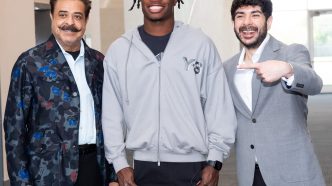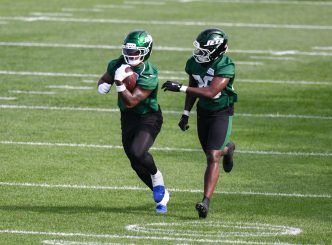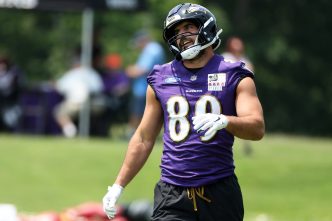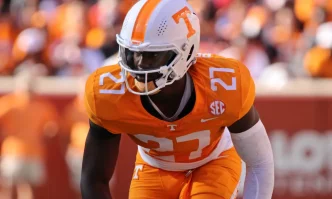The Jacksonville Jaguars made headlines at the 2025 NFL Draft on April 24, trading up to the No. 2 pick to select Colorado’s two-way star Travis Hunter, a Heisman Trophy winner renowned for his elite play at both wide receiver and cornerback. The Jags gave up significant draft capital—picks No. 5, 36, 126, and a 2026 first-rounder—to secure Hunter, signaling a bold new era under GM James Gladstone and head coach Liam Coen. Hunter, who has insisted on playing both offense and defense in the NFL, now joins a franchise that publicly plans to honor his wish. But will Hunter truly play both sides of the ball in Jacksonville, or is this more of a marketing promise than a practical reality?
Hunter’s college stats are staggering: in 2024, he recorded 96 catches for 1,258 yards and 15 touchdowns as a receiver, while also tallying 36 tackles, 11 pass breakups, and four interceptions as a cornerback. He played 1,484 snaps—713 on offense, 748 on defense—the most by any player since at least 2017. His versatility earned him the Heisman, Walter Camp, Biletnikoff, and Bednarik Awards, making him the first defensive player to win the Heisman since Charles Woodson in 1997, who also played both ways. Hunter’s pre-draft stance was clear: he’d quit football if not allowed to play both positions, a sentiment he reiterated at the NFL Combine in February 2025.
The Jaguars seem committed—at least on paper. Gladstone called Hunter a player who could “alter the trajectory of the sport,” emphasizing his dual first-round value as both a receiver and a corner. Coen, an offensive-minded coach, confirmed the initial plan is to use Hunter “primarily on offense while learning the defensive system,” with a package of defensive plays to ease him in. This approach, Coen noted, involves the entire organization—coaches, trainers, and sports scientists—to manage Hunter’s workload and health. The Jags see Hunter as a financial bargain, essentially getting two first-round talents for one rookie contract, which could help a team coming off a 4-13 season in 2024.
On offense, Hunter pairs with Pro Bowl receiver Brian Thomas Jr., giving quarterback Trevor Lawrence a dynamic duo to spark a passing attack that’s lacked consistency. Defensively, he bolsters a secondary that allowed the most passing yards per game in 2024 (257.4), potentially starting opposite Tyson Campbell. The Athletic reported that most NFL coaches and executives believe Hunter should focus on cornerback, playing 10-15 snaps per game at receiver. However, Jacksonville’s plan leans heavier on offense initially, possibly reflecting Coen’s background as Tampa Bay’s offensive coordinator, where he worked with explosive receivers like Mike Evans.
But the practical challenges are significant. Playing both ways full-time in the NFL, with its 17-game season and physical demands, is nearly unprecedented in the modern era. Hunter’s 1,484 college snaps are a feat, but the NFL’s speed, physicality, and longer schedule amplify the risk of wear-and-tear injuries. Historical two-way players like Woodson and Champ Bailey eventually specialized due to these demands. Coen acknowledged this, noting discussions with the training and nutrition staff to ensure Hunter can handle the load, but the lack of an empowered defensive coordinator on his staff suggests a potential imbalance in how Hunter’s roles are prioritized.
Hunter’s own expectations add pressure. He’s expressed a desire to play 100% of snaps at both positions, comparing himself to baseball’s Shohei Ohtani—a lofty goal that may not align with NFL realities. The Jaguars’ roster needs also complicate matters. Offensively, they need a WR2 to complement Thomas, but their defense, particularly the secondary, has more glaring holes. If Hunter excels at cornerback, the team might pivot to using him there more often, especially if injuries or performance gaps emerge elsewhere.
Fan and analyst sentiment reflects skepticism. Posts on X show excitement for Hunter’s potential, but many question the feasibility of a true two-way role, citing the NFL’s specialization trend. Some NFL decision-makers, per Yahoo Sports, criticized the trade’s cost, arguing the Jags overpaid for a player whose dual role might be more symbolic than sustainable. The Browns, who traded down and took Michigan DT Mason Graham at No. 5, were seen as winners in draft capital, highlighting the risk Jacksonville took.
Ultimately, Hunter will likely play both sides of the ball to some extent, but not equally. The Jaguars’ initial focus on offense suggests they’ll use him as a receiver first, perhaps 40-50 snaps per game, while sprinkling in 10-20 defensive snaps in passing situations where his ball skills can shine. This hybrid approach mitigates injury risk and leverages Coen’s expertise, but it falls short of Hunter’s full-time vision. If he proves durable and impactful, his defensive role could grow by 2026, especially if the Jags miss the playoffs and feel the sting of that 2026 first-round pick they traded away.
Hunter’s arrival makes the Jaguars more relevant and exciting, but the NFL’s grueling nature and strategic demands will likely force a choice eventually. For now, expect a calculated experiment—more receiver than corner, with flashes of two-way brilliance to keep fans buzzing. Whether that evolves into a true dual role depends on Hunter’s health, performance, and the Jags’ willingness to defy NFL norms.








